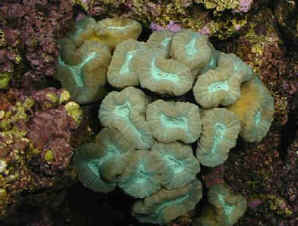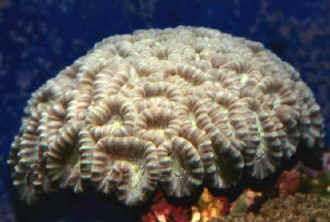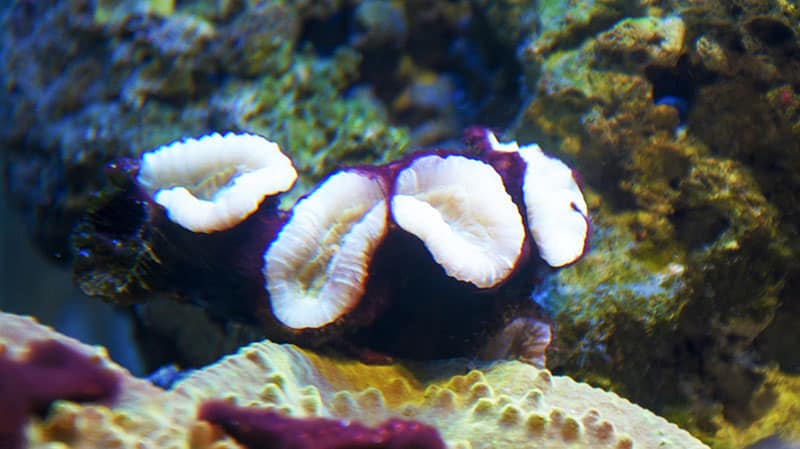The Candycane Coral Caulastrea furcata is a colorful species, usually with brown polyps and neon green centers. The outside brown part can also have lighter stripes radiating out from the center. It has been very successfully propagated in captivity. Some of the aquacultured colors of C. furcata are blue with green centers, yellow with green centers, and almost a burgundy red with a green center.
This species gets its name from the septa just under the flesh of the polyp that give it a striping appearance resembling a peppermint. Common names these corals are know for are Candy Cane Coral, Cat’s Eye Coral, Bullseye Coral, Torch Coral, and Candy Coral.
Next to the zoanthids, the Candy Cane Coral is pretty much a staple coral for most reef aquariums. They are the most recognizable species from the Caulastrea genus, and the most collected by aquarists. This coral is very similar to the Trumpet CoralC. echinulata. The main differences in appearance are that the trumpet is generally less colorful, and its polyps extend further from the skeleton on at the edges giving it the look of a “trumpet”. The trumpets’ polyps are also much more closely packed to give the appearance of one large coral. Another close relative, the Bullseye CoralCaulastrea curvata is even more openly branched than the Trumpet Coral. It is also captive propagated and readily available in some very attractive varieties.
The C. furcata is easy to care for and is a definite beginner’s coral. It likes a medium to low water movement and low to moderate lighting. These corals will expand in the morning before the lights are turned on and put out a circle of long tentacles similar to the pistols in a flower. Very interesting to watch! Candycane Corals do have big appetites, so they need to be fed regularly. They can be fed when the tentacles extend but it is not necessary to do so as they will feed during the day when food is present.
This is not a very aggressive species. Their sweeper tentacles are short and they seldom bother anything around them, but it is semi-aggressive if it is too close to other corals. In general, saying that a coral is peaceful due to shorter tentacles is not completely accurate. The Candycane Corals may only have 2″ sweeper tentacles, but they pack a bigger “punch” or stronger sting than many other corals that have 6″ sweeper tentacles.
The Candycane Coral may have shorter sweeper tentacles than other corals, however they can pack a much more powerful punch! Easy to space in a nano tank, the aquarist doesn’t have to worry too much about the coral stinging others that are 6″ away. Feed this coral often, every day if possible, since they are hungry corals that do well with minced marine flesh. Low to moderate light and turbid low to moderate water movement is best. Keep their branches clear of detritus and sponges which can cause tissue recession.
Scientific name
Family: Faviidae
Species: Caulastrea furcata
Distribution / Background
Caulastrea Coral Information: The Candycane Coral Caulastrea furcata was described by Dana in 1846. Some common names these corals are know for are Candy Cane Coral, Cat’s Eye Coral, Bullseye Coral, Torch Coral, and Candy Coral.. The C. furcata has been propagated in captivity.
Where Caulastrea Corals Are Found: C. furcata are found around the Seychelles and Maldives Islands to Fiji and Tonga, and around Australia. The reefs that they inhabit around Australia are the Great Barrier Reef, Coral Sea and the Scott Reef.
Caulastrea Coral Habitat: The C. furcata are primarily found on protected reef slopes with sandy substrate in shallow, bright water with a surging water flow.
Status
The C. furcata is on the IUCN Red List of Endangered Species as LC (Least Concern)
Description
What do Caulastrea Corals look like: The Candycane Coral C. furcata is a branching formation coral with the top of each branch having a single or double head, with one or more mouths. This species gets its name from the septa (teeth on the inside of the corallite or polyp wall) that protrude to just under the flesh of the polyp, giving it a striped appearance that resembles a peppermint.
The polyps of the Candycane Coral are usually round or oval and are about 9.5 to 10 mm in diameter. They are not packed together as closely as some of the other Caulastrea species. They appear independent and separate, but are joined to a common base. At times, zoanthids grow in-between the heads. In the wild, they have been found in colonies up to 16 feet (5 m).
The natural colors of the Candycane Coral are brown, yellow, burgundy, blue or green with a lighter or darker green oral disc and they usually have striations. Some of the aquacultured colors of C. furcata are blue with green centers, yellow with green centers, and almost a burgundy red with a green center.
The Candycane Coral C. furcata is the most commonly found Caulastrea species in the aquarium trade, and they usually have brighter colors than the other species. The Trumpet Coral C. echinulata is very similar in appearance, but is not quite as colorful as the Candy Coral.
| Differences between: Candycane Corals and Trumpet Corals | |
|---|---|
 |  |
Candycane Coral polyps are more colorful and loosely packed | Trumpet Coral polyps extend out like a trumpet and are tightly packed |
Photo Courtesy: John Rice | |
Difficulty of Care
Caulastrea Coral Care: The C. furcata is easy to care for, it can be recommended to beginners. It has been said that the green polyped animals are easier to maintain than the brown polyped specimens. Low to moderate lighting and a medium to low water flow is recommended. They are very sensitive to metal halides, lighting from these sources needs to be indirect. Also, make sure that detritus does not build up between the colony branches.
Foods / Feeding
Caulastrea Coral Feeding: The Caulastrea corals, like other large polyp stony (LPS) corals, have developed several feeding strategies. Through a symbiotic relationship with a marine algae, known as zooxanthellae, they receive some of their nutrients. They also capture planktonic organisms, food particles from the water column, and can absorb dissolved organic matter.
In captivity, Candy Cane corals will expand in the morning before the lights are turned on and put out a circle of long tentacles similar to the pistols in a flower. Very interesting to watch! They can be fed when their tentacles are out, but they will come out during the day if food is detected. Feed finely minced seafood of any kind as well as mysis, and similar sized foods. They do need to be fed at the very least twice a week, and grow quite well with regular feedings. It does help to turn the water pumps off during feeding.
Aquarium Care
Typical water changes of 20% a month, 10% biweekly, or 5% weekly are needed. It has been noted that 5% weekly water changes replenish many of the needed additives and it is ultimately cheaper than purchasing additives for the water. With higher concentrations of coral with calcareous skeletons though, there may be a need put in additional additives to maintain proper levels for good growth.
The following water supplements are suggested for Caulastrea species:
- Calcium: 400 to 430 ppm. If a large poly stony (LPS) coral does not have enough calcium, it will not grow. (Seachem makes a calcium additive that states 385 as sufficient)
- Alkalinity: 3.5 MEQ/L (8 to 11 dKh, 10 is recommended)
- Phosphates: 0, zero. Phosphates are the worst of all and all corals hate them.
- Magnesium: 1200 – 1350. Magnesium makes calcium available, so if your calcium is low, check your magnesium levels before adding any more calcium.
- Strontium: 8 – 10
Aquarium Parameters
A well-feed live rock/reef environment is what is needed for your Candycane Coral, along with some fish for organic matter production. A mature tank is recommended.
| Quick Reference Chart | |||
|---|---|---|---|
| Lighting: | |||
| Water Flow: | |||
| Temperament: | |||
Be sure to have proper water movement and provide sufficient lighting. It likes a medium to low water flow and low to moderate lighting. They are very sensitive to metal halides, and need to have indirect lighting from these sources. These corals will expand in the morning before the lights are turned on and put out a circle of long tentacles similar to the pistols in a flower. They can be fed when the tentacles extend but it is not necessary to do so. This is a semi-aggressive species when too close to other corals.
- Minimum Tank Size / Length:Nano tanks and larger
- Marine Lighting: Moderate to indirect bright
- Temperature: 74° – 83° F (23° – 28° C)
- Salinity / Specific Gravity: 1.023 – 1.025
- Water Movement: Moderate / turbulent, surging currents are said to help increase polyp division.
- Water Region: Middle of the aquarium
Compatibility and Social Behaviors
Caulastrea corals can be semi-aggressive when close to other corals, so do need some distance between themselves and others. In general, saying that a coral is peaceful due to shorter tentacles is not completely accurate. The Candycane Coral s may only have 2″ sweeper tentacles, but they pack a bigger “punch” or stronger sting than many other corals with 6″ sweeper tentacles. When the 6″ sweepers from other corals hit C. furcata, they will be harmed from invading the Candycane Coral’s space.
In the wild, the Caulastrea species are often found with commensal sponges, mollusks, zoanthids and other sessile invertebrates. Zoanthids tend grow in-between the coral’s heads, but do not seem to bother the coral.
Sex – Sexual differences
Unknown.
Breeding and Reproduction
The large polyp stony (LPS) corals are are hermaphrodites, male and female within the same organism, and can reproduce both sexually and asexually. In the wild they reproduce sexually by releasing eggs and sperm at the same time, resulting in a fertilized egg which then forms into a free-swimming planula larva.Eventually the planula larvae settles onto the substrate, becoming plankters. This then forms a tiny polyp which begins to excrete calcium carbonate and develops into a coral. Planula larvae are extremely vulnerable to predation, and very few survive. The C. furcata are hermaphrodites that fertilize externally through mass spawning events. The Caulastrea genus reproduce asexually as well.
In captivity, the C. furcata can propagate by fragmenting, as well as by intratentacular budding (when a polyp divides into more polyps and then pinches off to a new branch). Propagation is super simple with this genus! Simply cut the branch that the polyp head is on with a bone cutter or something that will cut clean and quickly. The only problem you may have is if you cut too close to the polyp and cause a fracture that tears the polyps flesh. This is a problem when using weak or dull scissors as well. Happily, they should heal with good water flow. Glue the frag to a plug or rock. You can use the 2-part epoxy or underwater putties.
Potential Problems
The Caulastrea spp. are fairly hardy but recession is seen at times on one or more polyps in a colony, but that does not mean the whole colony is in danger. Boring worms, sponges, and algae can cause this condition.
Availability
Caulastrea Corals for Sale: The Candycane Coral C. furcata is very easy to find at pet shops and on line. Online they can run about $30.00 to $60.00 USD or more depending on size and/or color. The C. furcata has been propagated in captivity. In general, aquacultured specimens are hardier, and have been developed into much more colorful animals, including more intense variations of their colors.
References
- Animal-World References: Marine and Reef
- Harry Erhardt and Horst Moosleitner, Marine Atlas Volume 2, Invertebrates (Baensch Marine Atlas), Mergus Verlag GmbH, Revised edition, 2005
- Eric Borneman, Aquarium Corals : Selection, Husbandry, and Natural History , TFH Publications, 2001
- Anthony Calfo, Book of Coral Propagation, Volume 1 Edition 2: Reef Gardening for Aquarists, Reading Trees; 2nd edition, 2007
- J.E.N. Veron, Corals of Australia and the Indo-Pacific , University of Hawaii Press; 2 Rev Ed edition, 1993
- Ronald L. Shimek, Guide to Marine Invertebrates: 500+ Essential-to-Know Aquarium Species, Microcosm, 2005
- Bob Goemans, Torch Coral, Caulastrea furcata, Animal Library, Saltwatercorner.com
Featured Image Credit: Candy cane coral (Caulastrea echinulata) by domdomegg, Wikimedia Commons CC Alike 4.0 International
